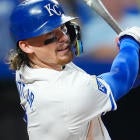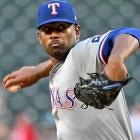
There weren't many landing spots Corbin Burnes could have ended up with this offseason that would have been better for his Fantasy Baseball value than the Orioles squad he just spent his 2024 with. But he just might have found one of them, agreeing late Friday to a six-year deal that lands him with the Diamondbacks.
The headline number here for Burnes is the $210 million price, as reported by Jon Heyman of the New York Post. However, with an opt-out after two years, the 30-year-old has the flexibility to try to lock down one more long-term deal if everything goes well over the next couple of years – while securing long-term stability in case it doesn't. And the Diamondbacks? Well, they get a workhorse who is coming off a 2.92 ERA – who flashed even more upside than that with some late-season tweaks.
We'll start there in our breakdown of this signing. Burnes had a solid season in 2024, his lone campaign with the Orioles, finishing with that 2.92 ERA over 194.1 innings of work. However, if you click past the ERA and dig into some of the deeper numbers, you'll notice some apparent red flags. The strikeout rate was down to 23.1%, the lowest of his career since a stint in the Brewers bullpen as a rookie back in 2018.
Not a great sign for a pitcher entering his 30s, right?
Dig in deeper still, you'll see that the primary issue is the regression of Burnes' cutter, which went from being arguably the best pitch in baseball a few years ago to being a pretty pedestrian offering in 2024 -- his 19% whiff rate ranked just 34th out of 44 pitchers who threw their cutters most often last season. For a pitch he throws 45% of the time, that's a bad sign, and was enough to push Burnes from the ranks of the truly elite starters down to the merely very good.
For much of 2024, Burnes' cutter lost movement along both the vertical and horizontal axes, as BaseballProspectus' Robert Orr noted late last season. He was getting behind the ball too much, generating more rise and less run with the pitch, rendering it … well, I won't be able to put it any better than Burnes himself colorfully did after a disastrous stretch in August:
"I was getting too efficient with how I was spinning it, which was making it a [uh … not good] four-seam fastball," Burnes told the Baltimore Banner in September. "And it was getting hit like a [uh, again, not good] four-seam fastball."
Burnes acknowledged his August struggles might have cost him "another run at the Cy Young," and that was enough to get back in the lab and try to fix the pitch. After sitting between 2-3 inches of horizontal break with the cutter for most of the season, it was back up to four inches in September, and the results were there, too – the whiff rate was 26.3%, while his expected wOBA allowed on the pitch was just .256. Both marks were the best results for any month in 2024, and more in line with what we saw from Burnes pre-2024, if not quite the peak of his powers.
And the thing is: He was already pretty good with his cutter at less than its best in 2024! Burnes finished as the No. 9 pitcher in Fantasy last season, and he might have been doing that without his best pitch. So it's not unreasonable to think he could be even better in 2025, right?
I think so. The cutter is part of it, but then there's also this landing spot. Now, I will grant that this is a park downgrade for Burnes, though not exactly an extreme one – Camden Yards had a 99 park factor overall from 2022 through 2024, while Chase Field sits at 101 on a scale where 100 is average and a higher number is worse for pitchers. Both parks suppress over-the-fence power well, but Arizona tends to boost other types of extra-base hits a bit more to make up for it. Again, it's a mild park downgrade, though one that might be overcome by the fact that Arizona might actually be one of the few spots with a better supporting cast than Baltimore's.
The Orioles were fourth in runs scored in 2024, which is pretty good – just think, they only scored 100 fewer runs than the Diamondbacks, who led the majors! That gap may shrink in 2025, but I think it's fair to say this is at least a mild upgrade in terms of run support, and could be an equal upgrade in defense behind Burnes – the Diamondbacks were second in StatCast's Outs Above Average metric, while the Orioles were 21st.
Burnes is also one of the most reliable sources of volume at the position, having stayed remarkably healthy over the past five seasons, missing just a handful of starts in 2020 with an oblique injury and a few more in 2021 with COVID-19. He's likely getting at least a push in terms of the situation he finds himself in relative to 2024, too. And he may have rediscovered the pitch that made him a Cy Young winner in 2021. That all sounds like a pitcher you want on your Fantasy team.
You do. He was my No. 4 starting pitcher in Fantasy before this signing, and I'm certainly not moving him down for it. I don't expect Burnes to pitch like it's 2021 again, but I do think he's about as good a bet as you'll find for 200-plus strikeouts, elite ratios, and very good win totals with that high-octane offense backing him up. He might not have the strikeout upside of Tarik Skubal or Paul Skenes, nor quite the dependable volume of Zack Wheeler. But once those three are off the board, I'm happy to take Burnes as the anchor of my pitching staff.
You won't find many better.
A question for the Orioles …
What's the plan here, exactly?
They made the big swing to trade for Burnes last offseason, a move that still left them a high-end pitcher short of having a true contender's rotation. As things stand, they feel even farther away heading into 2025, with Zach Eflin and Grayson Rodriguez at the top of the rotation and Dean Kremer, Tomoyuki Sugano, and Trevor Rogers likely to round things out. That's not a terrible rotation, but it hardly strikes fear in the hearts of opposing batters. And it won't match up well with whatever AL contenders they are likely to run into in the postseason.
Maybe Sugano can take the league by storm the way Shota Imanaga, another soft-tossing NPB import, did in 2024. Or maybe Rogers rediscovers the velocity he lost three years ago and get back to blowing hitters away. Or heck, maybe Eflin rediscovers his front-line form from 2023 or Rodriguez puts the recurring lat injuries behind him and becomes the ace he has only teased at being so far in his major-league career. You don't have to squint too hard to see any of those outcomes coming together, really.
But, "Hey, what if everything goes right" is not exactly a plan, is it? Especially not for a team with this much enviably cheap young talent offensive on board. That cheap talent is becoming less cheap by the day – the Orioles made it through Adley Rutschman's three minimum-salary seasons with zero playoff wins to show for it, for example. Rutschman is on the verge of making real money, and the other core pieces aren't far behind him. Aren't the Orioles exactly the team that should be paying Corbin Burnes for his early-30s seasons to try to get them over the top in the next handful of years?
There aren't many impact starting pitchers left on the market, and the ones who are out there are hardly better bets than Burnes, in either the short or long term. Jack Flaherty could conceivably out-pitch Burnes in 2025, but the Orioles also just watched a divisional rival back out of a trade for Flaherty over concerns about medicals. Nick Pivetta is another option, but he'll also vacillate between looking like he could be Baltimore's best pitcher and being even more combustible than Rogers from a start to start basis. He can help a rotation, but he's nobody's idea of a rotation savior.
So, again, what's the plan here, exactly? The Orioles still have a surplus of young hitters any team in baseball would love to build around, and Coby Mayo could certainly be the centerpiece for any ace out there on the trade market. But they might have missed their chance, watching Garrett Crochet go to another divisional rival earlier in the offseason. They could make a run at Dylan Cease, or drop down a few tiers and see if they can get Sonny Gray – or perhaps they could call the Marlins bluff and see if they'll make Sandy Alcantara available in trade.
Any of those moves would represent a significant upgrade to the top of the Orioles rotation, but they would also all beg the question: Why not just re-sign Burnes? All that would cost is money, after all, and the Orioles should have plenty of that available after spending the better part of a decade doing everything they could to keep payrolls as low as possible. The time for half-measures would seem to be over, with a young, cost-controlled, contending core in place. But the Orioles only went about 60% of the way there in trading for Burnes last offseason, and they've taken a couple of steps back in letting him walk since.
The offseason isn't over, but the Orioles seem frustratingly unwilling to step through their open window. Let's hope they have something big planned in the coming weeks and months to take that next step.
















